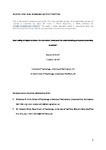Dual Coding of object relations: An alternative framework for understanding perceptual processing in autism?
| dc.contributor.author | Smith, Alastair | |
| dc.contributor.author | Milne, E | |
| dc.date.accessioned | 2017-12-06T10:21:51Z | |
| dc.date.issued | 2017-06-16 | |
| dc.identifier.issn | 1350-6285 | |
| dc.identifier.issn | 1464-0716 | |
| dc.identifier.uri | http://hdl.handle.net/10026.1/10371 | |
| dc.description | peerreview_statement: The publishing and review policy for this title is described in its Aims & Scope. aims_and_scope_url: http://www.tandfonline.com/action/journalInformation?show=aimsScope&journalCode=pvis20 | |
| dc.description.abstract |
Glyn Humphreys presented a model of attentional selection that was based on within- and between-object relations. In this paper we argue that the model may offer a more principled, flexible, and tractable approach to understanding perceptual differences in autism than current leading accounts (i.e., theories of Weak Central Coherence and Enhanced Perceptual Functioning). We briefly review these accounts before making a case for the necessity of an alternative conceptualization. We then review the underlying principles of the Dual Coding account, and explore whether it can be applied to findings in autism research. Since the model focuses on attentional mechanisms, rather than perceptual processing, we argue that it may provide a more valid foundation for understanding the relationship between local and global perception in existing autism research findings, which tend to be reported in the absence of fundamental differences in visual perception. It is also firmly rooted in empirical evidence from typical and atypical populations, allowing scientists to make predictions about visual behaviour that can be applied across groups, and in a manner that is fully consistent with existing knowledge about perception. Irrespective of how convincing the reader may find this argument, we believe that it befits Glyn Humphreys’ scientific heritage to show how his work might still provide a clear and elegant solution to a controversial issue. | |
| dc.format.extent | 1-11 | |
| dc.language | en | |
| dc.language.iso | en | |
| dc.publisher | Informa UK Limited | |
| dc.subject | Dual Coding | |
| dc.subject | perceptual organization | |
| dc.subject | autism | |
| dc.subject | Weak Central Coherence | |
| dc.subject | Enhanced Perceptual Functioning | |
| dc.title | Dual Coding of object relations: An alternative framework for understanding perceptual processing in autism? | |
| dc.type | journal-article | |
| dc.type | Review | |
| dc.type | Journal | |
| plymouth.author-url | https://www.webofscience.com/api/gateway?GWVersion=2&SrcApp=PARTNER_APP&SrcAuth=LinksAMR&KeyUT=WOS:000423979800010&DestLinkType=FullRecord&DestApp=ALL_WOS&UsrCustomerID=11bb513d99f797142bcfeffcc58ea008 | |
| plymouth.issue | 1-3 | |
| plymouth.volume | 25 | |
| plymouth.publication-status | Published | |
| plymouth.journal | Visual Cognition | |
| dc.identifier.doi | 10.1080/13506285.2017.1332702 | |
| plymouth.organisational-group | /Plymouth | |
| plymouth.organisational-group | /Plymouth/Faculty of Health | |
| plymouth.organisational-group | /Plymouth/Faculty of Health/School of Psychology | |
| plymouth.organisational-group | /Plymouth/REF 2021 Researchers by UoA | |
| plymouth.organisational-group | /Plymouth/REF 2021 Researchers by UoA/UoA04 Psychology, Psychiatry and Neuroscience | |
| plymouth.organisational-group | /Plymouth/Users by role | |
| plymouth.organisational-group | /Plymouth/Users by role/Academics | |
| plymouth.organisational-group | /Plymouth/Users by role/Researchers in ResearchFish submission | |
| dcterms.dateAccepted | 2017-05-12 | |
| dc.rights.embargodate | 2018-6-16 | |
| dc.identifier.eissn | 1464-0716 | |
| dc.rights.embargoperiod | Not known | |
| rioxxterms.versionofrecord | 10.1080/13506285.2017.1332702 | |
| rioxxterms.licenseref.uri | http://www.rioxx.net/licenses/all-rights-reserved | |
| rioxxterms.licenseref.startdate | 2017-06-16 | |
| rioxxterms.type | Journal Article/Review |


